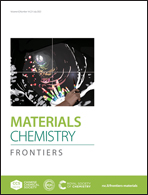Molecular engineering of g-C3N4 with spatial charge separation for enhancing photocatalytic performances†
Abstract
The intramolecular doping of donor units or acceptor units in carbon nitride (g-C3N4, CN) is regarded as an effective method for regulating electron structure and enhancing the catalytic activity of CN. Herein, benzene rings and eosin Y (EY) co-grafted CN with carbon vacancies (EY-PhCN) was prepared by calcining a supermolecular precursor consisting of melamine, cyanuric acid, and benzonquanmine followed by covalently hooking the EY. Theoretical and experimental results demonstrated the directional electron transfer, spatially isolated electron–hole pairs and increased light response in the resulting ultrathin holey EY-PhCN. An optimal H2 production rate of 4.44 mmol g−1 h−1 was obtained over the 1%Pt-loaded EY-PhCN catalyst. The corresponding apparent quantum yield was 27.38% at 420 nm. Moreover, the EY-PhCN exhibited high CO2 reduction rate with H2O. The yields of CO and CH4 were 61.91 and 13.75 μmol g−1, respectively within 5 h light irradiation, higher than that of CN (CO: 24.60 μmol g−1, CH4: 8.51 μmol g−1). The work may give new insight into associating carbon vacancies and edge decoration on CN to achieve remarkably enhanced photocatalytic activity.



 Please wait while we load your content...
Please wait while we load your content...